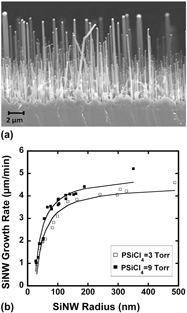Article contents
Gas phase equilibrium limitations on the vapor–liquid–solid growth of epitaxial silicon nanowires using SiCl4
Published online by Cambridge University Press: 04 July 2011
Abstract

Epitaxially oriented silicon nanowires (SiNWs) were grown on (111) Si substrates by the vapor–liquid–solid technique in an atmospheric-pressure chemical vapor deposition (APCVD) system using Au as the catalyst and SiCl4 as the source gas. The dependencies of SiNW growth rate on the growth temperature and SiCl4 partial pressure (PSiCl4) were investigated, and the experimental results were compared with calculated supersaturation curves for Si obtained from a gas phase equilibrium model of the SiCl4–H2 system. The SiNW growth rate was found to be weakly dependent on temperature but strongly dependent on the PSiCl4, exhibiting a maximum value qualitatively similar to that predicted from the equilibrium model. The results indicate that SiNW growth from SiCl4 is limited by gas phase chemistry and transport of reactant species to the growth surface under APCVD conditions. The experimental results are discussed within the context of a gas phase mass transport model that takes into account changes in equilibrium partial pressure due to curvature-related Gibbs–Thomson effects.
Keywords
- Type
- Articles
- Information
- Journal of Materials Research , Volume 26 , Issue 17: Focus Issue: Nanowires: Fundamentals and Applications , 14 September 2011 , pp. 2207 - 2214
- Copyright
- Copyright © Materials Research Society 2011
Footnotes
This author was an editor of this journal during the review and decision stage. For the JMR policy on review and publication of manuscripts authored by editors, please refer tohttp://www.mrs.org/jmr_editor-manuscripts/
References
REFERENCES
- 13
- Cited by


